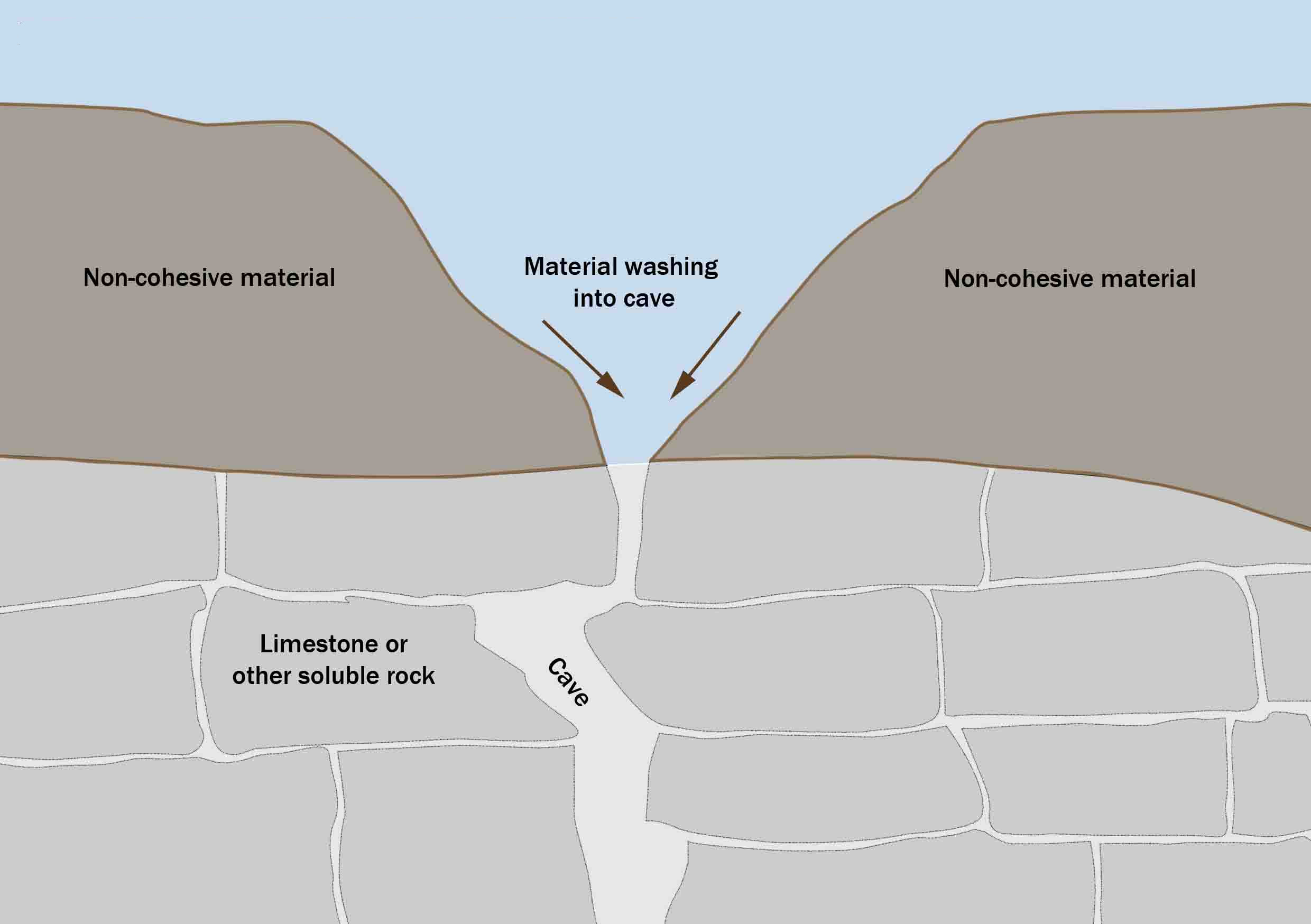Suffosion on:
[Wikipedia]
[Google]
[Amazon]
Suffosion is one of the two 
geological
Geology () is a branch of natural science concerned with Earth and other astronomical objects, the features or rocks of which it is composed, and the processes by which they change over time. Modern geology significantly overlaps all other E ...
processes by which subsidence
Subsidence is a general term for downward vertical movement of the Earth's surface, which can be caused by both natural processes and human activities. Subsidence involves little or no horizontal movement, which distinguishes it from slope mov ...
sinkhole
A sinkhole is a depression or hole in the ground caused by some form of collapse of the surface layer. The term is sometimes used to refer to doline, enclosed depressions that are locally also known as ''vrtače'' and shakeholes, and to openi ...
s or dolines are formed, the other being due to collapse of an underlying cave
A cave or cavern is a natural void in the ground, specifically a space large enough for a human to enter. Caves often form by the weathering of rock and often extend deep underground. The word ''cave'' can refer to smaller openings such as sea ...
or void, with most sinkholes formed by the suffosion process. Suffosion sinkholes are normally associated with karst topography
Karst is a topography formed from the dissolution of soluble rocks such as limestone, dolomite, and gypsum. It is characterized by underground drainage systems with sinkholes and caves. It has also been documented for more weathering-resistant ro ...
although they may form in other types of rock including chalk
Chalk is a soft, white, porous, sedimentary carbonate rock. It is a form of limestone composed of the mineral calcite and originally formed deep under the sea by the compression of microscopic plankton that had settled to the sea floor. C ...
, gypsum
Gypsum is a soft sulfate mineral composed of calcium sulfate dihydrate, with the chemical formula . It is widely mined and is used as a fertilizer and as the main constituent in many forms of plaster, blackboard or sidewalk chalk, and drywa ...
and basalt
Basalt (; ) is an aphanitic (fine-grained) extrusive igneous rock formed from the rapid cooling of low-viscosity lava rich in magnesium and iron (mafic lava) exposed at or very near the surface of a rocky planet or moon. More than 90 ...
. In the karst of the UK's Yorkshire Dales
The Yorkshire Dales is an upland area of the Pennines in the historic county of Yorkshire, England, most of it in the Yorkshire Dales National Park created in 1954.
The Dales comprise river valleys and the hills rising from the Vale of York w ...
, numerous surface depressions known locally as "shakeholes" are the result of glacial till
image:Geschiebemergel.JPG, Closeup of glacial till. Note that the larger grains (pebbles and gravel) in the till are completely surrounded by the matrix of finer material (silt and sand), and this characteristic, known as ''matrix support'', is d ...
washing into fissures in the underlying limestone.

Process
Suffosion occurs when loose soil,loess
Loess (, ; from german: Löss ) is a clastic, predominantly silt-sized sediment that is formed by the accumulation of wind-blown dust. Ten percent of Earth's land area is covered by loess or similar deposits.
Loess is a periglacial or aeoli ...
, or other non-cohesive material lies on top of a limestone substratum containing fissures and joints. Rain and surface water gradually wash this material through these fissures and into caves beneath. Over time, this creates a depression on the landscape of varying depth.
Suffosion versus suffusion
Suffosion is a destructive process that creates instability leading to collapse of the soil structure, characterized by both mass loss and volumetric contraction. In suffosion, coarser particles lose their point-to-point contact. This is in contrast to suffusion, which is non-destructive and is characterized by mass loss without change in volume. In suffusion, coarser particles remain in point-to-point contact and fine particles are removed through the voids between them.Examples
The following sites are examples of sinkholes formed by suffosion: *Whitepit, south ofPriddy
Priddy is a village in Somerset, England in the Mendip Hills, close to East Harptree and north-west of Wells. It is in the local government district of Mendip.
The village lies in a small hollow near the summit of the Mendip range of hills, a ...
, Somerset, UK;
References
Suffosion Cave geology Karst Geomorphology Soil science Dinaric karst formations Karst formations {{Geology-stub